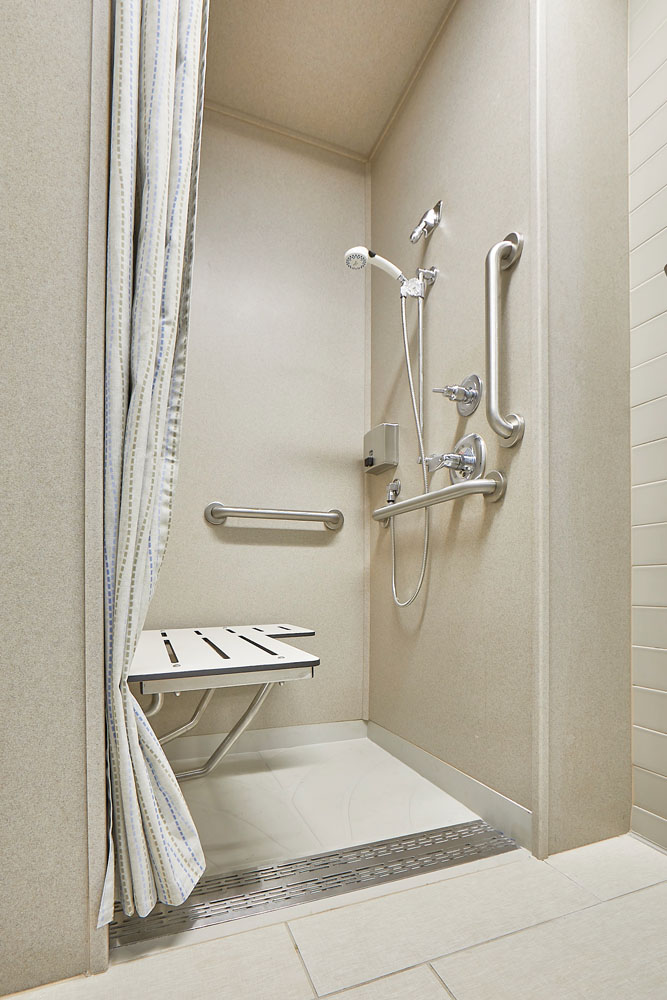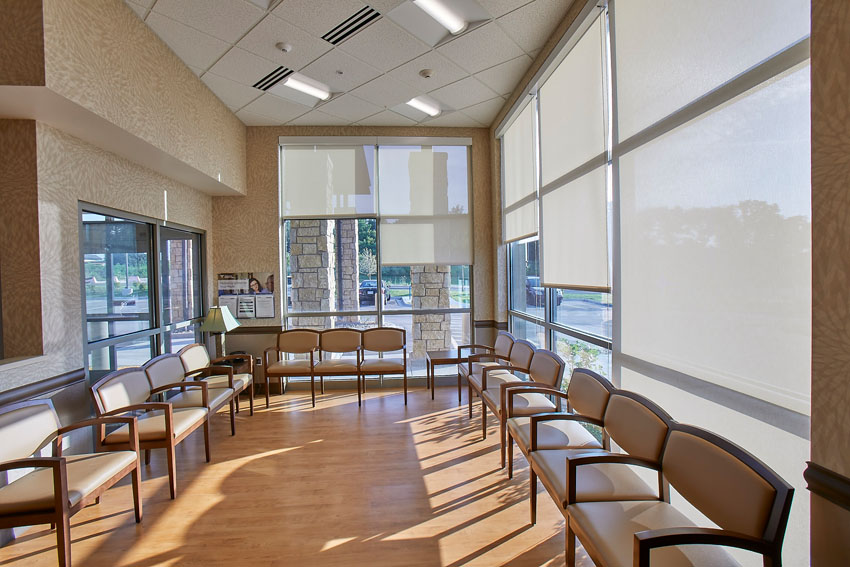Healing Environments for Health Care
Providing Solutions
Based on the above, the accessible range of someone in a wheelchair is pretty limited: on the order of 10–14 inches of height or less above a sink. That does not allow a lot of room to access medications or other needed health products. Of course, everyone’s individual needs are different, and there is usually not a one-size-fits-all answer to the day-to-day living in an accessible situation. So, innovation is often needed to provide the best outcomes.
An excellent example of such innovation is found in a medicine cabinet now on the market that combines accessibility and ingenuity. It allows someone in a wheelchair to reach the bottom of the cabinet door above the sink and open it to reveal the contents inside. While normally someone would only be able to reach the bottom shelf of the cabinet, this design includes a vertically hanging handle inside that is connected to a cleverly designed shelf system that the user can pull easily downward. The individual shelves adjust with gravity as they are lowered, allowing all of the contents to remain on the shelf and be placed directly above the sink in front of the person. Hence, all of the contents of the cabinet are now accessible to the user. When done, the shelves are simply pushed back up into place and the door closed. This synchronized operation allows the user to act completely independently from the wheelchair without requiring assistance or standing.
In addition to this helpful functionality, a residential style and intentionally simple aesthetic are provided. This medicine chest provides a clean-looking mirrored cabinet that is angled downward on the front so that wheelchair users can see themselves easily. The cabinet is also illuminated both on the outside and inside, providing light above the sink and easy visibility of the contents of the chest.
Liz Congero is vice president of sales and marketing for Aamsco Lighting and has seen the results of this type of innovation. She says, “The overall net effect is that elderly or physically challenged people are able to remain in their homes or a long-term care facility and maintain a level of independence. This helps with a person’s well-being, which can also be linked to addressing concerns about being able to have access to their medications without assistance.” Clearly, more innovation like this is called for that provides the needed accessibility in a way that blends with architectural design in health-care facilities.
Accessible Showers
Shower stalls are an area where accessibility is paramount in many health-care facilities. ICC ANSI 117.1, Section 608: Shower Compartments is the governing standard here and offers guidance based on the type of shower being provided. Three specific types of showers are covered: transfer showers where a wheelchair bound person can transfer to a (usually) ell-shaped seat; roll-in showers that may or may not include a rectangular fold-down seat; and an alternate roll-in shower with a partially enclosed configuration. For each of these options, minimum clearances, sizes, and dimensions are identified for adequate accessibility by a person in a wheelchair.
Beyond the physical makeup of the shower stalls, there are specific requirements for some details too. These include requirements for grab bars showing the locations, dimensions, orientation (horizontal or vertical), and details of the size and shape of the grab bars are provided. Additionally, requirements for the different types and shapes of shower seats are spelled out in detail. All of these parameters are fairly straightforward to address but need to be coordinated based on the type and size of the shower being designed.
In addition to the above, there are several notable design considerations for accessible showers. One is the use of a trench drain along the leading edge of the shower to allow for a true roll-in condition with a minimum threshold. Another consideration is the use of shower curtains instead of doors. One advantage of employing shower curtains is the potential for easier compliance where space may not allow for shower doors. Employing a shower curtain with a wide lip and Velcro® side-seals edge can lessen the occurrence of overspray, thus reducing slip-fall risk for the bather and attending staff. Further, the location of convenience items such as soap dishes and caddies is important. The key here is to be aware of and avoid any conflicts with other elements in the shower space, specifically grab bars. Also, do not forget to take into account ADA Section 308 regarding unobstructed forward and side reach ranges when positioning soap dishes and caddies.
In the interest of simplifying the design of accessible shower stalls, there are fully prepared and assembled shower stalls available that have taken all of these things into account. Some of the preferred ones use solid-surface panels as a shower-enclosure material. Since solid surface is non-nutritive, it does not promote the growth of mold and mildew, and it resists bacterial growth. Solid surface also offers a great alternative to tile, with no grout to trap mold and mildew. Where grout cracks or falls out, there is risk of water getting behind the tile, leading to tiles failing or moisture seeping into the substrate. Further, installation of solid-surface shower surrounds can be finished in one-third the time of traditional tile.
Shower Seating

Photos courtesy of ASI
A slow-closing shower seat with damped gas springs does not slam down when lowered.
Many health-care facilities contain showers with a seat to allow for patient comfort or accommodate a temporary or permanent inability to stand through a shower. The preferred option is to provide a seat that moves or folds up out of the way to allow the greatest flexibility. Of course, its design and materials need to address hygiene and ease of cleaning too, all while providing an attractive appearance.
While there are a number of choices for such shower seating, the preferred option is for an L-shaped seat that closes smoothly. Specifically, models that use gas-charged struts assist one-handed opening by allowing the slowly lowering seat to drop into its operating position. The mechanism also assists in partial closing without creating any unexpected movements or disturbing loud noises. Guide brackets with a spring detent prevents the seat from dropping and provides positive support while in use, as well as locking in its storage position. A typical left-hand arrangement meets ADA Accessibility Guidelines and the needs of the physically disabled and elderly. For cleanliness and durability, a seat made from ½-inch-thick, one-piece solid-core phenolic is preferred. The frame, support legs, flanges, and bracket should be specified as type 304 satin-finish stainless steel.

Photo courtesy of Inpro
Accessible shower stalls made from durable solid-surface material can be fabricated in advance to meet health-care project needs and requirements.
INTERIOR TREATMENTS
The interior treatments of health-care spaces can have a direct effect on the way people feel and recover from procedures and the care they receive. With that in mind, we look closer at a few things to consider.
Cordless Window Shades
Controlling daylight and glare while providing some privacy along windows is a design necessity in many cases for health-care buildings. In response, textured roller shades can be used, which allows diffused daylight to pass through but the fabric appearance of the shade to reduce the total light. Thus they reduce glare, add comfort, and produce a favorable light quality inside the building while still providing a degree of privacy or views through to the outdoors as needed.
Cordless window shades for commercial use are made of long-lasting, durable fabrics and side channels. A spring roller system allows manual adjustment of the shade with considerable ease. The cordless design, incorporating spring roller mechanisms, makes them a safer option for areas where cord safety is a concern, particularly in pediatric or mental health areas. Typically made from a combination of materials, they are easy to clean without removing the shade. From a design and light-control standpoint, they are available in single- or dual-shade configurations for partial or total light control. A privacy track can also be included to keep the shades in place and provide additional light blocking.
For areas where damage or tampering may occur, there are cordless window shades that are a self-contained system specifically designed to resist such damage. This type of system features side channels and an extremely durable security box fascia to protect its mechanical components, making it one of the toughest cordless window shades on the market.
Beyond these functional features, it is possible to design and create a theme from room to room by custom printing the shades with a graphic design selected by the designer. Printed shades can create a welcoming atmosphere in addition to hiding unsightly outdoor scenery. They are also less likely to be damaged or vandalized. It is entirely possible to use custom landscapes or artwork, or simply apply standard fabric patterns to a shade for simplicity.
From an energy standpoint, cordless window shades have been studied and shown to help with the rejection of solar heat with a positive impact on reducing energy needs for cooling. For example, independent research using computerized energy models showed that annual energy savings related to space cooling, heat rejection, and ventilation fans could be realized between 5–9 percent. These savings were attributed to the ability of the fabric to reflect solar heat and keep the building from overheating on sunny days.

Photo courtesy of Inpro
Interior cordless window shades with textured fabric can provide privacy or maintain connections to the exterior while helping with energy perfor-mance by reducing solar heat gain.
Notice

www.aamsco.com/mirrors/wheelchair-medicine-chest


www.inpro.com

www.kohler.com

www.lonseal.com

www.waclighting.com









